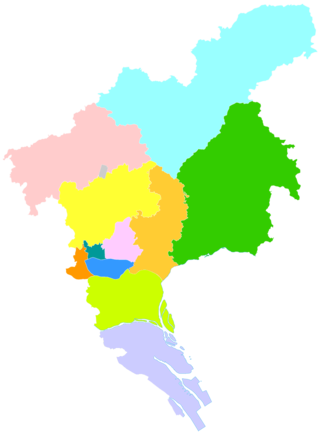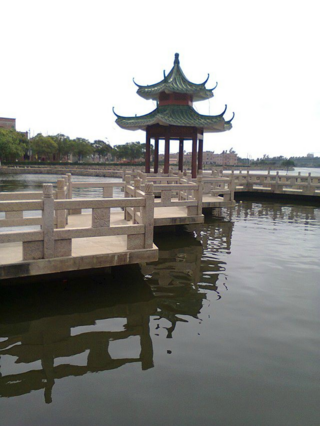
Gaoyao, alternately romanized as Koyiu, is an urban district of Zhaoqing in western Guangdong, China. Its population in 2010 was 706,000.

Sihui, formerly romanized as Szewui, is a county-level city in the west of the Pearl River Delta region in Guangdong province, China. It is administered as part of the prefecture-level city of Zhaoqing. Sihui's population is 542,873 in 2010.

Heshan, formerly romanized as Hokshan, is a county-level city of Jiangmen City in the southern part of Guangdong Province, China with a total land area of 1,081 square kilometres (417 sq mi) and a population of 530,684 inhabitants as of 2020 census and some 200,000 internal migrants. The city is now being conurbated with Jiangmen and so included in the Guangzhou-Shenzhen Pearl River conurbation with more than 65,57 million inhabitants. There are approximately 360,000 people of Heshan origin or descent living in other parts of the world, particularly in the Americas such as Chile, Peru and the United States.

Qingyuan, formerly romanized as Tsingyun, is a prefecture-level city in northern Guangdong province, China, on the banks of the Bei or North River. During the 2020 census, its total population was 3,969,473, out of whom 1,738,424 lived in the built-up area made of urbanized Qingcheng and Qingxin districts. The primary spoken language is Cantonese. Covering 19,015 km2 (7,342 sq mi), Qingyuan is Guangdong's largest prefecture-level division by land area, and it borders Guangzhou and Foshan to the south, Shaoguan to the east and northeast, Zhaoqing to the south and southwest, and Hunan province and Guangxi Zhuang Autonomous Region to the north. The urban core is surrounded by mountainous areas but is directly connected with Guangzhou and the Pearl River Delta by Highway 107.

Sanshui District, formerly romanized as Samshui, is an urban district of the prefecture-level city of Foshan in Guangdong province, China. It had a population of 622,645 as of the 2010 census. It is known for the "Samsui women", emigrants who labour in Singapore, and for a large fireworks explosion in 2008.

Yangjiang, alternately romanized via Cantonese as Yeungkong, is a prefecture-level city in southwestern Guangdong Province in the People's Republic of China. It borders Maoming to the west, Yunfu to the north, Jiangmen to the east, and looks out to the South China Sea to the south. The local dialect is the Gaoyang dialect, a branch of Yue Chinese. During the 2020 census, its population was 2,602,959 inhabitants of whom 1,292,987 lived in the built-up and largely urbanized area comprising Jiangcheng District and Yangdong County.

Xinyi, alternately romanized as Sunyi, is a county-level city in Guangdong Province, China. It is administered as part of the prefecture-level city of Maoming in the southwestern corner of the province, bordering Guangxi to the west. As of the 2020 census, it had a population of 1,014,577 people. Though its metro area is much smaller with 418,731 inhabitants considered urban.

Conghua District, alternately romanized as Tsungfa, is one of 11 urban districts and the northernmost district of the prefecture-level city of Guangzhou, the capital of Guangdong Province, China. Conghua connects the Pearl River Delta with the mountainous area of northern Guangdong. Within China, it is known for its hot springs and lychees. It covers an area of 1,974.15 km2 (762.22 sq mi), with a population of 543.377 in 2006. Its GDP was RMB10.369 billion.

Zengcheng District is one of 11 urban districts of the prefecture-level city of Guangzhou, the capital of Guangdong Province, China.

Huangling County is a county in the north of Shaanxi province, China, bordering Gansu province to the west. It is under the administration of the prefecture-level city of Yan'an. The county spans an area of 2,286.7 square kilometres (882.9 sq mi), and has a permanent population of 130,100 people as of 2012.

Gaozhou is a county-level city in southwestern Guangdong Province, China. Formerly the primary city in the area, it is now administered as part of the prefecture-level city of Maoming. As of the 20210 census, Gaozhou had a population of 1,328,658 living in its 3,270.86 km2 (1,262.89 sq mi) territory, nevertheless its built-up area is much smaller. The locals speak a variation of the Gaozhou dialect. It is best known in China for being the ancestral home of Leo Ku.

Lechang is a county-level city in the northern Guangdong province, People's Republic of China, bordering Hunan province to the north. It is under the administration of Shaoguan prefecture-level city.

Deqing County, formerly romanized as Takhing, is a county in western Guangdong province, China, under the administration of the prefecture-level city of Zhaoqing.
Fengkai County is a county in western Guangdong Province, China, under the administration of the prefecture-level city of Zhaoqing. It was formed in 1961 from the merger of Fengchuan and Kaijian Counties, which were formerly romanized as Fungchuan and Hoikin respectively.

Longmen County, alternately romanized as Lungmoon, is a county of Guangdong, China, administered as part of the prefecture-level city of Huizhou. In 2004, Longmen County had a population of 320,596 residing in an area of 2,295 square kilometers (886 sq mi).

Huiyang District (postal: Waiyeung; simplified Chinese: 惠阳区; traditional Chinese: 惠陽區; pinyin: Huìyáng Qū; Jyutping: wai6joeng4 keoi1 is a district of Huizhou, Guangdong province, People's Republic of China. It was renamed in 2003 amid the restructuring of districts and counties in Huizhou. Formerly named Huiyang city, its size shrank after the restructuring with several towns incorporated into the Huicheng district of Huizhou. Huiyang is the southern urban center of Huizhou along with Huicheng as the northern urban center.

Huazhou, formerly romanized as Fachow or Fahsien, is a county-level city in southwestern Guangdong Province, China. Bordering Guangxi to the north, it is administrated as part of the prefecture-level city of Maoming. During the 2010 census, its population was 1,178,809, of which 320,418 were considered urban.

Yangchun, alternately romanized as Yeungchun, is a county-level city in southwestern Guangdong, China, administered as a part of the prefecture-level city of Yangjiang. Yangchun has an area of 4,055 km2 (1,566 sq mi) and had approximately 1.05 million inhabitants in 2003.
Xinxing County, alternately romanized as Sunhing, is a county of the prefecture-level city of Yunfu in the west of Guangdong province, China.

Wuchuan is a county-level city in southwestern Guangdong province, China. It is the easternmost county-level division of the prefecture-level city of Zhanjiang. Wuchuan covers an area of 848 square kilometers (327 sq mi), with an estimated population of 1,111,394 as of 2013.



















